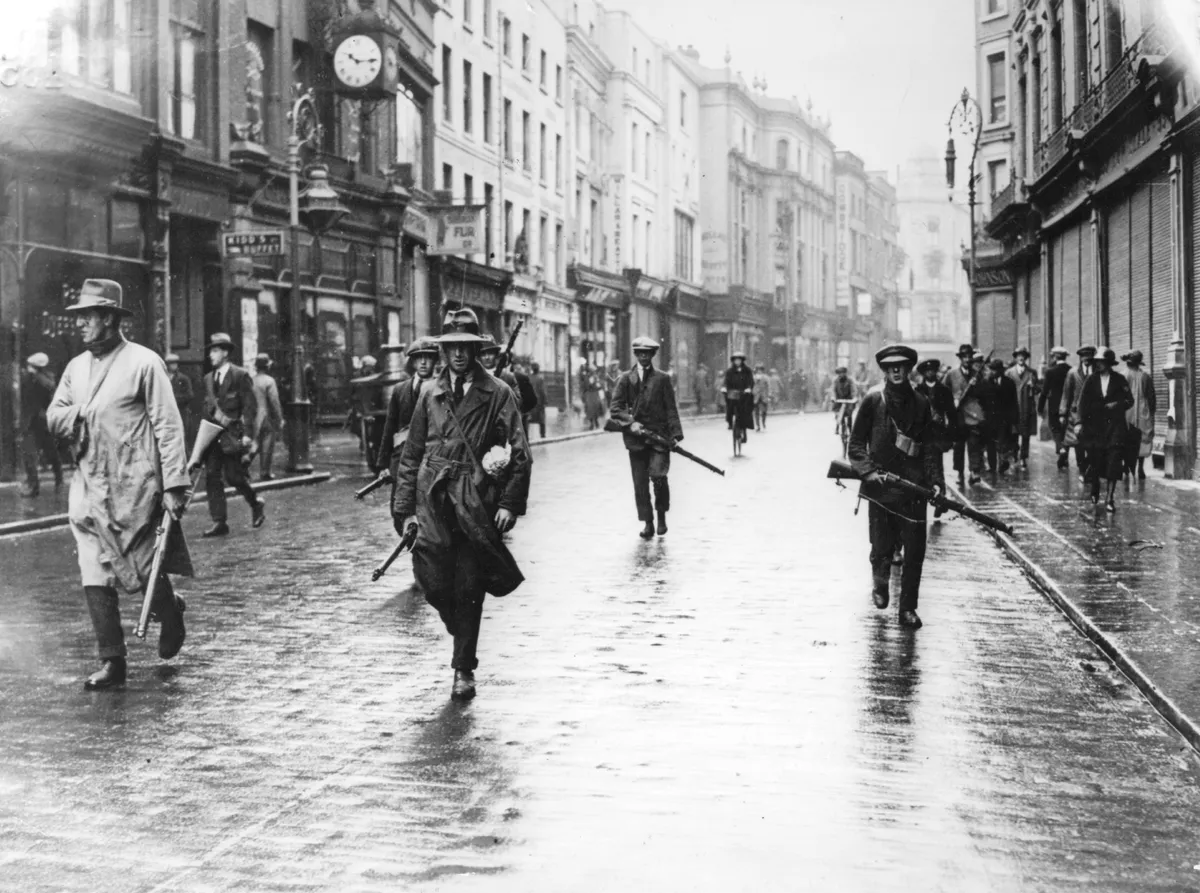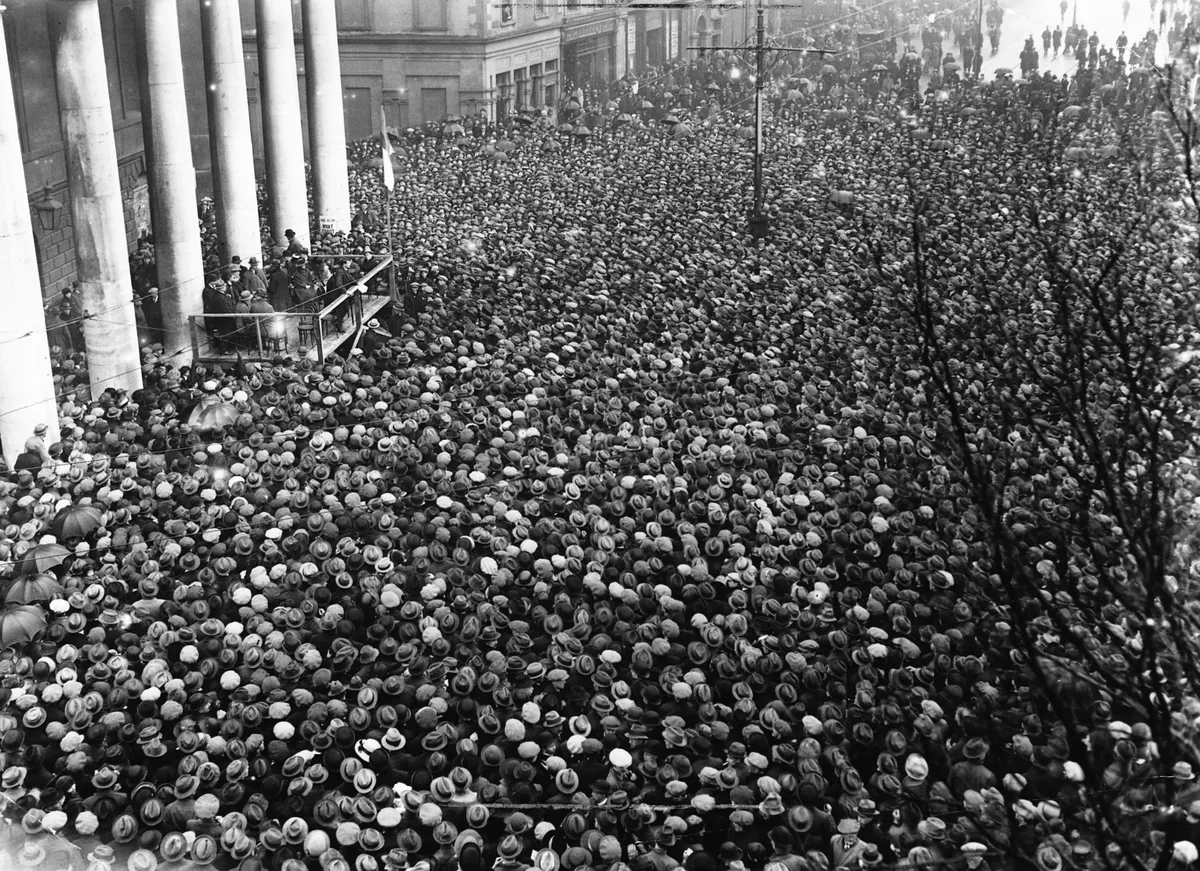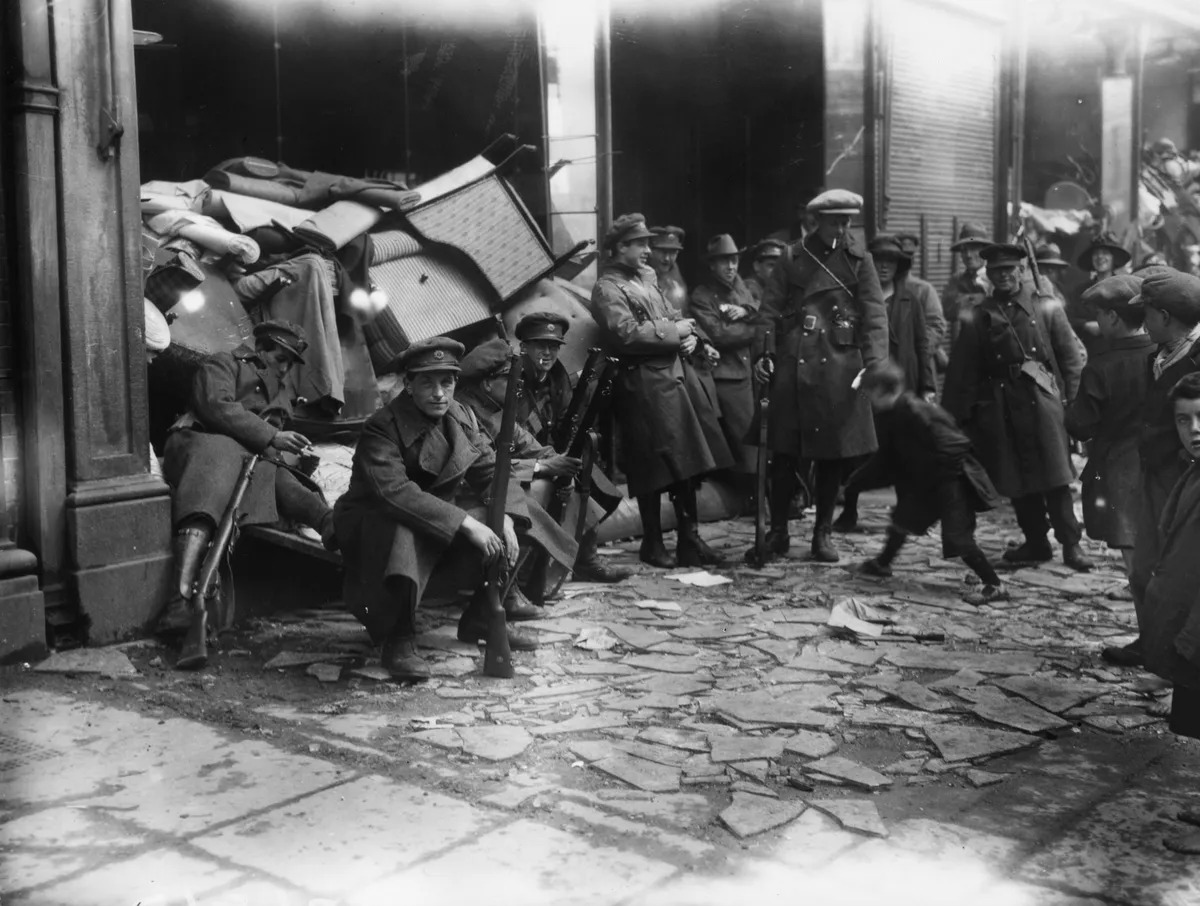The Irish Volunteers (Irish: Óglaigh na hÉireann) was a military group established in November 1913 by Irish nationalists in response to the formation in January 1913 of the Ulster Volunteers. The Ulster Volunteers were opposed to legislation that had been introduced in 1912 to grant Home Rule for Ireland.
Companies of Irish Volunteers were organised in parishes across Ireland. With cobbled-together uniforms and wooden guns, they mobilised, marched and were trained, often by Irishmen who had served in the British Army.
The Home Rule legislation was passed in the 1914 Government of Ireland Act, but its implementation was postponed during the First World War. At the outbreak of the war the Irish Volunteer movement split, with the majority joining the British army.
The minority who remained were closely aligned with the Irish Republican Brotherhood, a secret society created in the 19th century who planned the 1916 Easter Rising. Although the Rising was not widely supported, public outrage at the subsequent execution of its leaders increased support for the Republican movement.
In the 1918 British general election the Irish republican party Sinn Féin won a majority in Ireland and formed a breakaway government, declaring Irish independence. This led to the 1919-21 Irish War of Independence. In the war the volunteers became known as the Irish Republican Army (IRA), fighting a guerrilla war against the British Army. They are separate from the different paramilitary organisations using the name IRA that have formed since the War of Independence.

How to find Irish Volunteers' records
Although the Irish Volunteers and IRA mimicked the British Army in organisation, they did not create the records of a traditional armed force. Bearing in mind that for the duration the activities of the Volunteers and IRA were secret, few records were kept that might identify the membership.
There were no enlistment papers or contemporary records of serving soldiers. Volunteers were issued with a membership card, but very few of these survive and they hold little useful information anyway. The majority of the records that document the men and women who were active during the period were created years later from people’s memories, and may not accurately reflect the facts.
From 1923 the newly formed Irish Free State provided compensation for the wounded and for the families of deceased members of the IRA, Irish Volunteers and Irish Citizen Army. In 1924 legislation was introduced to provide a Military Service Pension to members of those organisations who saw active service between 1916 and 1923. The legislation was amended in 1934 to increase the scope of these awards, and it is from this era that we find the largest collection of material relating to men and women active in the revolutionary period.

In order to confirm that a pension applicant had actually seen active service, the authorities requested that former commanding officers generate a list of the men and women who served in their battalion, identifying them by each battalion company. These are known as the IRA Nominal Rolls and are available to download from the website of the Irish Military Archives.
The lists are not complete, but those that do survive may be the only record of a rank-and-file Volunteer’s service. The records are organised geographically and can be accessed through a divisional map of Ireland. Since most Volunteers joined the company that was established in their home parish, the first step is to establish an address for the Volunteer in the second decade of the 20th century. The easiest way to do this is with the 1911 census, which is also freely available online.
The address should lead you to the division, brigade, battalion and company that served the area in which your ancestor lived. For example, a Volunteer from Bantry in Co Cork should be found in the 1st Southern Division, Cork III Brigade, Bantry Battalion.
Each battalion was divided into companies, and the Nominal Rolls include lists of the men and women who served in each company, as recalled by the commanding officer. Unfortunately, these lists have not been indexed, so a manual search of the documentation for the relevant battalion is required.
Identifying an ancestor on the Nominal Rolls will identify the company and battalion that they served in, as well as their commanding officers and fellow Volunteers. Rather than a regimental number, it is this information that will help to build a picture of your ancestor’s time as a Volunteer.
Note that pensions were not automatically granted – the Volunteer was required to make an application, and not every active Volunteer applied. A relative may have applied for a pension or a medal on their behalf, as was the case with the family of Thomas Bryan, who Boy George discovered was executed in 1921 in his episode of Who Do You Think You Are?
The records of those who did apply for a pension, or a medal, have also been published online by the Irish Military Archives and can be searched by name.
Some applications run to hundreds of pages and include letters of support, queries regarding the amount granted and receipts for expenses as well as personal testimony from the applicant and a completed application form detailing their entire service between 1916 and 1923, making these documents a gold mine of information. However, even if your ancestor did not apply, applications from other Volunteers in their company will provide insight into your relative’s activities.
Alongside the Nominal Rolls and Military Service Pension applications, the third record set published by the Irish Military Archives is the Bureau of Military History Witness Statements, which were gathered by the Bureau from the late 1940s. Participants in the revolutionary period were asked to write an account of their experiences from 1913 to 1923, on the understanding that their accounts would not be released until after their deaths, to encourage them to be as frank as possible. These statements are available online.
You can view the witness statement of Major Patrick Colgan which featured in Dev Griffen's episode and documented Patrick Weafer's involvement in the Easter Rising of 1916 with this link here.

Later in the century, obituaries in local papers often refer to a former Volunteer’s Republican activities, and may identify the company in which they served. A large number of old Irish newspapers can be searched on Irish News Archive; you will also find contemporary reports about the Irish Civil War. The Irish Volunteer was published between 1914 and 1916 and can be searched for free on the Military Archives website along with its successor An tÓglach Magazine which ran from 1918 up to 1933..
A journey into these records is not always easy – you may read testimony that makes you shudder. But the publication of these sources online has made us all historians of Ireland’s revolutionary past, with an opportunity to discover and tell the story of our ancestor’s role and experience in the fight for Irish independence.
